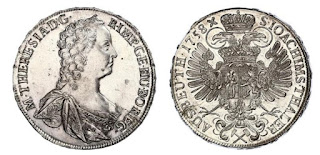The broad silver coin known everywhere as the Maria Theresa Thaler (MTT) is familiar to most numismatists the world over, since it was first minted in 1741 AD. It is named after Empress Maria Theresa who was the ruler of the Habsburg dominions, for 40 years from 1740 AD to 1780 AD, and was the only female to hold that position.
It is the only coin to have been continuously minted from 1741 AD to date, with all those minted after 1780 AD, bearing the same year of 1780 AD.
Maria Theresa Thaler
Maria Theresa was the sovereign of Austria, Hungary, Croatia, Bohemia, Transylvania, Mantua, Milan, Lodomeria and Galicia, the Austrian Netherlands and Parma. By marriage, she was Duchess of Lorraine, Grand Duchess of Tuscany and Holy Roman Empress. The MTT was the circulating currency of the Holy Roman Empire and its dominions and one of the most important trade coins in Europe and the world. Since the death of Maria Theresa in 1780 AD, the coin has always been dated 1780 AD and continues to be produced in both proof and uncirculated conditions.
Maria Theresa was born on 13th May 1717 AD and was the daughter of Emperor Charles VI (reigned 1711-1740 AD). No male child of his survived infancy and the succession, devolved onto his daughter.
Archduchessa Maria Theresa, by Andreas Moller
She married Francis Stephen of Lorrain in February 1736 AD
Charles VI died in October 1740 AD, leaving Austria in an impoverished state, bankrupt by the recent Turkish war and the war of the Polish Succession, and leaving Maria Theresa in a difficult situation.
She wanted to secure the Imperial office for her husband, but Francis did not possess enough land or rank within the Holy Roman Empire. In order to make him eligible for the Imperial throne, Maria Theresa made Francis Stephen co-ruler of the Austrian and Bohemian lands in November 1740 AD
She received the title of Empress Consort when her husband Francis of Lorraine was elected to the throne as the Holy Emperor in 1745 AD.
Upon his death in 1765 AD, their ambitious son became Holy Roman Emperor as Joseph II, co-ruler with his mother. The dynasty was known as Habsburg-Lorraine.
Maria Theresa died in November 1780 AD. Her body is buried in the Imperial Crypt in Vienna next to her husband in a coffin she had inscribed during her lifetime.
An array of coins in copper, billon and silver were struck for Maria Theresa at Vienna, Graz, Hall, Kremnitz (northern Hungary), Nagybanya, Prague (Bohemia), Siebenburgen and Karlsburg (Transylvania), Gunzburg (now northern Bavaria). In German speaking countries, following a spelling reform in 1901, ''Thaler'' was written as ''Taler''. These taler coins displayed the empress' bust at various ages, ranging from the youngest draped bust of 1741 through older draped busts struck until her consort's death in 1765. The final coin was struck in 1780. The talers of 1780, would become the famous "world trade coin''.
The Maria Theresa Thaler was originally issued in Austria between 1740 and 1780, the years that Maria ruled and was the currency of the Austrian Empire, But the MTT quickly became the standard trade coin, and several nations began striking these. Between 1751 and now, over 800 million coins have been minted at Birmingham, Bombay, Brussels, London, Paris, Rome and Utrecht, in addition to the Habsburg mints at Gunzburg, Hall, Karlsburg, Kremnica, Milan, Prague and Vienna. Bombay struck 18 million over two years, Paris, over 4.5 million between 1936 and 1945, Brussels struck just under 10 million and London struck over 15 million between 1936 and 1940. There are over 150 different variants, and virtually all dies produced before 1850 AD had minor differences.
Shipping crates of MTT in Ethiopia, 1910
The MTT came to be used as currency in large parts of Africa and Middle East until World War II. It was common from North Africa to Somalia, Ethiopia, Kenya and to the coast of Tanzania and Mozambique. Its popularity in the Red Sea region was unparalleled. It was formerly also the currency of the Hejaz, Yemen, the Aden Protectorate as well as Muscat and Oman. During the World War II, in the Japanese occupation of Indonesia, people preferred this currency too. The coin remains popular in North Africa and Middle East to this day in its original form.
The Maria Theresa Thalers (Coins)
1 Thaler, Maria Theresa, Austria-Habsburg, 1780 AD, silver (0.833), weight 28.066 g, diameter 42 mm, thickness 2.5 mm ,
Half Thaler, Maria Theresa, Austria-Hamburg, 1751-1754 AD, silver, weight 14 g, diameter 34 mm,
Obverse: Bust of Maria Theresa facing right
Reverse: Crowned double headed imperial eagle with composite arms (Syria shield at the center)
1 Thaler, Maria Theresa, Bohemia, 1758-1759 AD, silver
1 Thaler, Maria Theresa, Margraviate of Burgau (Austrian States), 1773-1780 AD, silver, weight 28.06 g




















Rajeev, Yet another thoroughly educative blog post. As good as the earlier ones. Keep them coming
ReplyDeleteGreat education. You grasp on your subject is simply stupendous. I learn something new every time I open your blog. Thanks for sharing your knowledge and insight on the subject. Keep them coming.
ReplyDelete